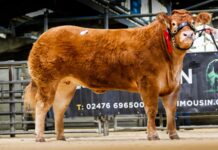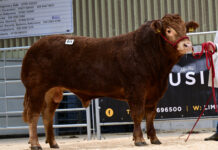Since this feature was compiled Gordon & Julie Sedgewick of Ricknall Grange Farm, Aycliffe, Co Durham have gone on to win the highly prestigious Beef Farmer of the Year title in the 2015 Northern Farmer of the Year Awards. Commenting on the award, Julie said: “We were thrilled to be nominated let alone win and particularly within such a tough contest.” Our congratulations go to the Sedgewicks and here we feature the prominent role the Limousin breed plays within their enterprise.
 Gordon and Julie Sedgewick’s commercial cattle enterprise relies on selling quality store calves at 9-12 months old, with the knowledge that they will go on and finish well for the buyers – and for that job, they have never considered using any breed other than the Limousin.
Gordon and Julie Sedgewick’s commercial cattle enterprise relies on selling quality store calves at 9-12 months old, with the knowledge that they will go on and finish well for the buyers – and for that job, they have never considered using any breed other than the Limousin.
The couple run a total of 850 acres (234 arable and 560 of grass), between two tenanted farms in Co Durham – Binchester Hall, at Bishop Auckland, and Ricknall Grange, Aycliffe. When they took on Binchester Hall back in 1996, they brought with them a sheep flock which they’ve now built up to 800 ewes (North of England Mules and Suffolk crosses), with all progeny, by the Suffolk, Texel and Charollais sires, finished at home.
The suckler herd was established in 1996 with some dairy cross heifers from Gordon’s brother, John. They were put to the Limousin, and some British Blue has been used on some of the plainer cows over the years, to form the basis of the herd of mainly black cows, which all go to the Limousin bull.
“I was always interested in showing commercial cattle, so Limousins appealed to me because of the shape and style of the calves and the fact they do well at the store market. They just clicked with us straight away and seemed to suit the type of farm, so we continued to keep home-bred heifers and bought in some more three-quarter Limousin type cows. As a suckler cow, they are ideal, with plenty milk and they are able to keep their condition without the need for a lot of supplementary feeding,” explained Julie.
With more shed space and grass available since taking on Ricknall Grange five years ago, Gordon and Julie have been able to put further focus on the beef herd. They grow their own straw, which helps keeps costs down, and many of the female calves are now kept for replacements, with the aim of increasing the herd to 120 cows, from its current 95.
 The majority of the calving takes place in March/April, and December/January, and all inside for management purposes. Julie says the calves generally need very little attention when born and they try not to interfere unless really necessary.
The majority of the calving takes place in March/April, and December/January, and all inside for management purposes. Julie says the calves generally need very little attention when born and they try not to interfere unless really necessary.
“We’ve recently invested in a Moocall calving sensor system which we’ve had good success with so far, and we also scan all the cows, which is a useful management tool, as it’s usually very accurate, to within a week.”
Bulls are always bought at pedigree sales, and the couple admit it can often be difficult to find what they’re looking for within their budget. Alongside looks, they study EBVs – especially calving ease and maternal traits – and health status, when making a choice. Current bulls include Saunders Favori (bought for 5500gns in 2012), Confluence Fadell (bought for 4200gns in 2012), and more recently, Saunders Imperial, purchased in May this year for 5200gns.
“Fadell has bred very well for us; he has a tremendous top and loin on him and a lovely quiet temperament. He bred our baby beef champion at LiveScot last year. We’ve just started using Imperial, and we’re hoping he’ll work really well with the Favori daughters.”
Julie is passionate about showing commercial calves, and the show team is now mainly made up of home-bred animals, which she says is particularly rewarding. They exhibit locally, and at the Great Yorkshire and Northumberland, plus several of the winter primestock events.
“We get help from Neil Slack with showing the calves – he normally halter trains them for us and often shows them too. Whilst I love going to the shows and the preparation, I’m not that keen on actually being in the ring myself!
“Showing can be a great advert for selling calves, but I think primestock showing is very important for the industry too. Many showing enthusiasts are not full-time farmers themselves, but they are buying off farmers, giving them a boost at the sales, and in-turn, encouraging commercial producers to spend a bit more on a bull, to get those quality calves,” explained Julie, adding that it is more often than not Limousin-bred cattle that lift the top tickets at primestock events.
“I was involved in organising the Beef Expo event this year, where we had an entry of 43 Limousin heifers – more than any other breed – and that must coincide with what the butchers want,” she said.
And for the Sedgewicks, as breeders of those calves, the fact they can get them away at 9-12-months is ideal for their set-up. The calves are normally weaned off their mothers six weeks before selling, and fed a beef ration and silage inside, before being sold through the ring at Hexham.
 The last batch to be sold, in spring 2015, was one of 19 bullocks at 9-11-months, which averaged out at £1031 (with a top of £1200), and 14 heifers, which leveled at £908, topping at £980.
The last batch to be sold, in spring 2015, was one of 19 bullocks at 9-11-months, which averaged out at £1031 (with a top of £1200), and 14 heifers, which leveled at £908, topping at £980.
“Hexham Mart is 40 miles away from us, but we’ve always got on well selling there, it has a great customer base from all over the country,” said Julie.
That buyer preference towards the Limousin crosses was notable, says Julie, when they used a native breed on some of the heifers as a trial, and found the price and demand for the calves to be far lower.
“I couldn’t see us using any other breed now, the Limousins suit our system perfectly, with room for the next buyer to make a profit too. Looking from a commercial point of view, I think the breed in general has improved a lot over the years – they are far quieter than they once were, with great loins on them, and good length,” added Julie.


















